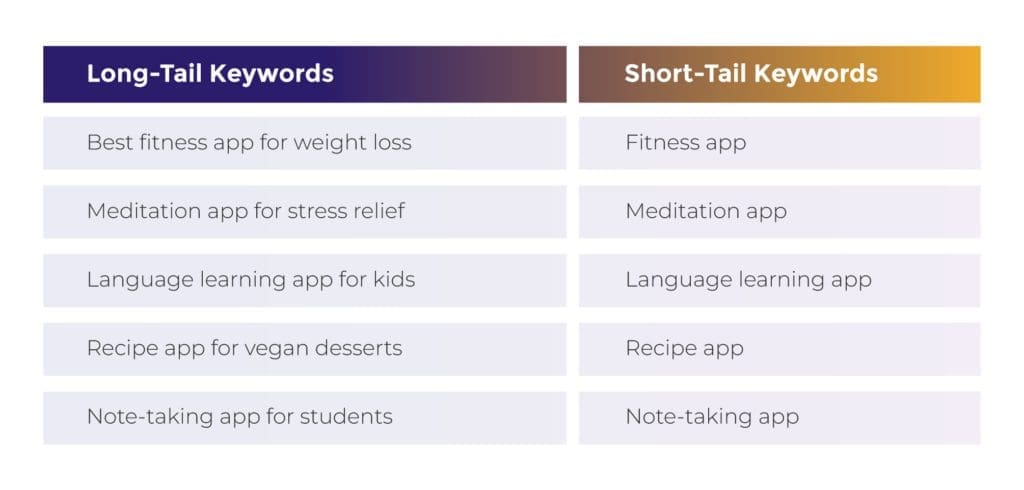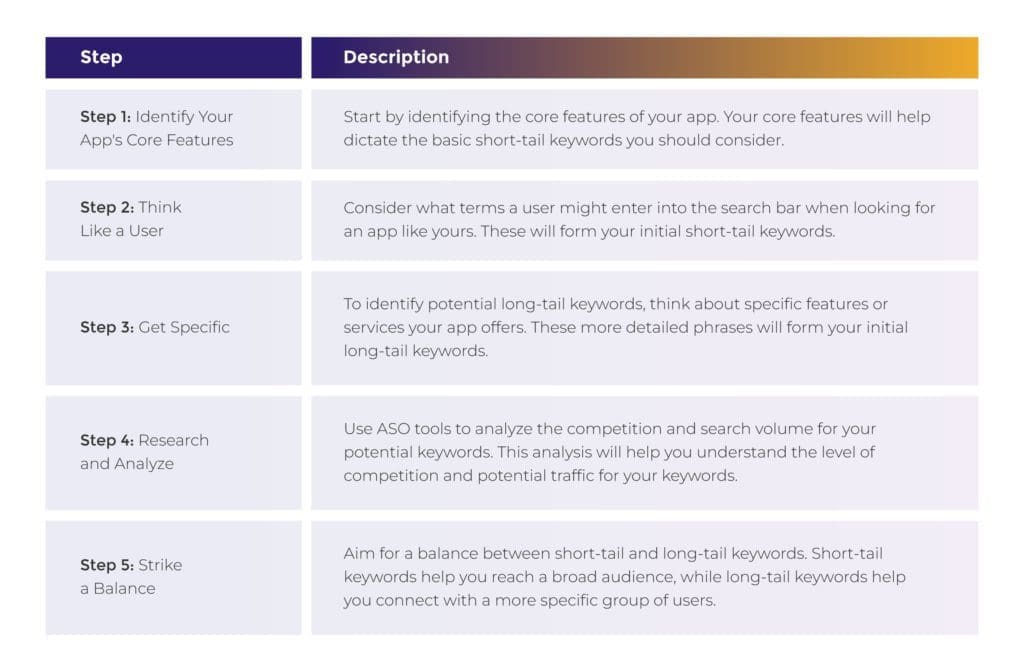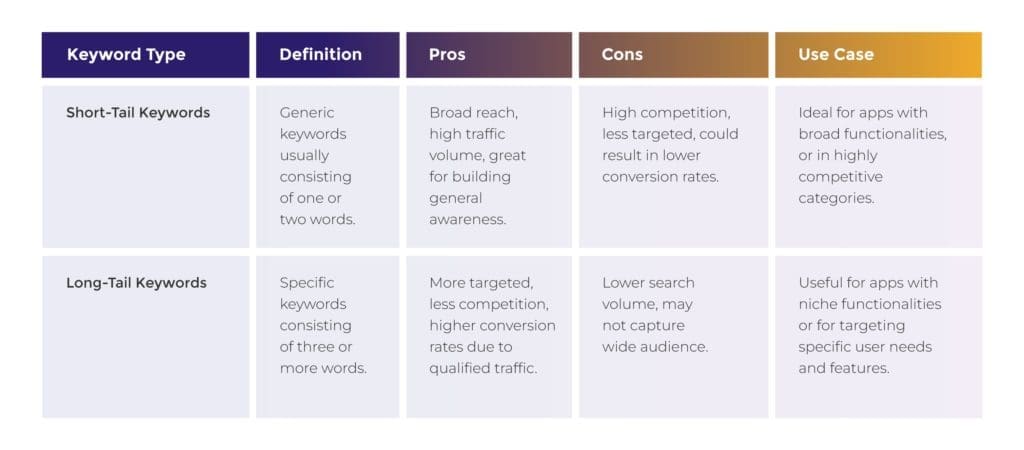Introduction to keyword research for ASO
Just as a compass guides a hiker through unfamiliar terrain, keyword research leads an app to potential users. Effective keyword research is an essential part of App Store Optimization (ASO), a series of strategies designed to enhance app visibility and conversion rates in app stores. In this article, we’ll deep dive into the world of keyword research for ASO. Starting from understanding the definition and importance of keywords, we’ll walk you through the fundamentals of keyword research and how to conduct it effectively. Further, we’ll share best practices in using keywords for ASO, common mistakes to avoid, and how to adapt your keyword strategy. Let’s get going, shall we?
Table of Contents
Understanding Keywords in ASO
In the context of ASO, a keyword is a specific term or phrase that users type into the app store search bar when looking for apps. Keywords should be seen as the bridge between your app and potential users; they facilitate discoverability and relevancy. Think about a fitness app. If a potential user types in “workout tracker” or “daily exercises,” your app would be more likely to appear in their search results if those keywords are effectively used in your app’s metadata. Conversely, if your keywords are centered around “diet plan” or “calorie counter,” the user might not discover your app even though it might have been exactly what they were looking for. Just as the skeleton is crucial to the human body, keywords are integral to ASO. Keywords increase app visibility by improving search ranking, thereby increasing downloads. There’s a direct relationship between keywords and app visibility; effective keyword usage translates to higher visibility. And that is essentially what we all are competing for. An optimized keyword strategy can lead to a significant increase in downloads. As we like to say here at Admiral, “Keywords in ASO are like a GPS, guiding potential users to your app amidst the sea of applications in the app store.” Simply, imagine an app as a store in a huge mall and keywords as the signs that guide customers to it. Without the right signs, your store remains invisible to the shoppers.

Fundamentals of Keyword Research for ASO
When working on your keyword research, understanding the differences between long-tail versus short-tail keywords is crucial. Short-tail keywords are generic, consisting of one or two words, while long-tail keywords are more specific, consisting of three or more words. The former have high competition but also high traffic, while the latter have less competition but more qualified traffic.

Choosing between long-tail and short-tail keywords can be a challenge, but here is a step-by-step guide to help:
Step 1: Identify Your App’s Core Features
Start by identifying the absolute core features of your app. Are you offering a crypto app? A dating app? A mobile game? Your core features will help dictate the basic short-tail keywords you should consider.
Step 2: Think Like a User
Consider what terms a user might enter into the search bar when looking for an app like yours. If your app is a fitness app, users might search for terms like “workout,” “exercise,” or “fitness tracker” – these are your short-tail keywords.
Step 3: Get Specific
To identify potential long-tail keywords, think about specific features or services your app offers. For a fitness app, long-tail keywords might include phrases like “personalized workout routines,” “daily calorie tracking,” or “yoga for beginners.”
Step 4: Research and Analyze
Use ASO tools to analyze the competition and search volume for your potential keywords. Short-tail keywords may have high competition, making it harder for your app to rank highly. Conversely, long-tail keywords might have lower competition but also lower search volume.
Step 5: Strike a Balance
Aim for a balance between short-tail and long-tail keywords. Short-tail keywords help you reach a broad audience, while long-tail keywords help you connect with a more specific group of users looking for exactly what your app offers. Remember, keyword analysis rests on the trifecta of relevance, difficulty, and traffic. Keywords must be relevant to your app, strike a balance between difficulty (competition) and traffic (search volume), and consider localizing keywords for global reach to appeal to different demographics and regions. To make it easier for you to remember, we’ve built this table for you.

In our quest to provide a comprehensive guide on App Store Optimization (ASO), we’ve put together a table that compares and contrasts the use of long-tail and short-tail keywords. The table breaks down these two key components of ASO by providing clear definitions, pros and cons, and relevant use cases. 
How to Conduct Keyword Research for ASO (tools we use)
Keyword research commences with brainstorming initial keywords – think about the words users would use to find your app. Next, employ keyword research tools like Sensor Tower, Mobile Action, or AppTweak to identify popular keywords, their difficulty, and search volume. There are a lot of different keyword research tools out there on the market. Here are some that ASO marketers are using for their ASO keyword analysis.
Sensor Tower
Sensor Tower provides valuable data about keywords, including their popularity and competitiveness. This tool offers features like keyword suggestions, keyword translation for localization, and a keyword spy feature to keep an eye on competitors’ keywords. It also helps to track the performance of your chosen keywords over time. This insight is invaluable for maintaining a competitive edge in the app market.
Mobile Action
Mobile Action offers an ASO intelligence feature that provides comprehensive data on keyword rankings. It’s also known for its keyword tracking tool, which shows changes in keyword performance over time. Mobile Action allows for monitoring of competitor’s keywords and can provide suggestions for keywords you might have missed.
AppTweak
AppTweak is a great tool for keyword research. It provides an extensive keyword analysis and the impact of these keywords on the app’s visibility. It suggests new keyword opportunities, provides insights about your competitors’ keyword strategies and can track the evolution of keywords over time.
Remember to reevaluate your keywords
Finally, a crucial part of keyword optimization is re-evaluating and refining keywords periodically. This is because trends, user behavior, and market conditions can change, and your ASO strategy should adapt to these changes. Reviewing your keyword performance monthly or quarterly and making necessary adjustments ensures that your app remains visible and competitive. Don’t forget to analyze competitor keywords. Understanding what keywords your competitors are ranking for, can provide inspiration and reveal gaps in your own strategy. Learn More: Why Ratings and Reviews Are Crucial for App Store Optimization (ASO) Success
ASO Keywords Best Practices
Titles and subtitles should contain your most important keywords. But remember, while keywords are crucial, user readability should not be compromised. In terms of keyword density, think Goldilocks – not too much, not too little, just right.
Keyword Placement in Titles and Subtitles
1. Use Important Keywords in the Title
The app title holds significant weight in app store algorithms. Therefore, include your most important keyword(s) in the title. However, ensure it still sounds natural and describes your app accurately.
2. Leverage the Subtitle
Subtitles are an excellent place to insert additional important keywords. It should complement the title and further describe the app’s purpose or main features.
3. Avoid Keyword Stuffing
Overstuffing can result in penalties, while too few can lead to missed opportunities. Keep your keyword strategy fresh by regularly updating your keywords. Just like how a ship adjusts its sails to catch the wind, you should tweak your keywords to catch the trends. With that said, here are some of our recommended best practices for ASO.
Optimal Keyword Density
1. Maintain Balance
While it’s beneficial to use keywords in your app’s description, avoid overuse. A good rule of thumb is to have a keyword density of about 2-3%.
2. Distribute Keywords Naturally
Keywords should be naturally integrated into the text. This not only improves readability but also helps avoid penalties from app stores.
Frequency for Updating Keywords
1. Regular Updates
Keep an eye on your keyword performance and make updates regularly. Typically, reviewing and updating your keywords every 4-6 weeks is a good practice.
2. Respond to Market Trends
If you notice a trend or a change in user behavior that’s relevant to your app, don’t wait for the next update cycle. Make changes as needed to take advantage of trending keywords.
3. Post-Update Analysis
After updating keywords, monitor their performance. This data will provide insights for the next update cycle. As always, using keywords strategically and keeping them updated is a dynamic process that plays a crucial role in the success of your ASO efforts. Focus and consistency is the way!
Common ASO mistakes to avoid
Wrote it once, now writing it twice – avoid keyword stuffing! Aim to maintain a natural and balanced flow of language in your app description. Remember, you’re writing for humans first, then algorithms. If you’ve already committed this mistake, go through your app description and reduce keyword density to around 2-3%. You should ensure keywords are used in a way that makes sense in the context of your app and its features.
Ignoring localization
Ignoring localized keywords is another pitfall. Imagine trying to sell ice in Alaska because you didn’t consider the local climate; localizing keywords ensures your app appeals to the right audience. By not using localized keywords, you limit your app’s visibility in various regions. Therefore, we recommend for you a practice to localize your app’s keywords for every market you’re targeting. This involves translating and adapting keywords to fit local languages and search habits. However, if you’ve for some reason have neglected localization, consider utilizing localization tools or hiring professional localization services to accurately translate and adapt your app’s keywords and descriptions for each targeted market.
Not monitoring keyword performance
If you are not keeping an eye on your keywords’ performance, you might be missing out. Big time. This can lead to missed opportunities and essentially, ineffective ASO strategies. Try to schedule regular times for keyword performance review and adjustment. Use keyword tracking tools to gain insight into how your keywords are performing over time. If you haven’t been monitoring keyword performance, start now. Set up a regular review schedule (every 4-6 weeks) and use ASO tools to monitor the performance of your keywords. Adjust your keyword strategy based on the insights you gain. By following these tips and maintaining vigilance with your keyword strategy, you’ll be in a good position to maximize your app’s visibility and potential success in the app store.
Conclusion on keyword research for ASO
Now that you have (hopefully) a comprehensive understanding of the importance of keyword research in App Store Optimization and how to effectively carry it out, it’s time for you to start your ASO keyword research journey. Let’s quickly summarize the key takeaways from this article:
- Keyword Understanding: Keywords act as the bridge between your app and potential users. Effective keyword usage can significantly increase app visibility and downloads.
- Keyword Research: This is a vital part of ASO. It’s crucial to understand the differences between long-tail and short-tail keywords and how to strike a balance between keyword relevance, difficulty, and traffic.
- Keyword Tools: Tools like Sensor Tower, Mobile Action, and AppTweak can be invaluable in identifying popular keywords, their difficulty, and search volume.
- Keyword Placement & Density: Strategic keyword placement within the app title and subtitle is essential. Remember to maintain a keyword density of around 2-3% to avoid penalties.
- Regular Updates: Keep your keyword strategy fresh by updating it regularly. This not only allows you to adapt to changes in trends but also helps you to optimize your app’s visibility and success continuously.
- Common Mistakes: Be aware of the common pitfalls such as keyword stuffing, ignoring localized keywords, and failing to monitor keyword performance.
Remember, ASO is a marathon, not a sprint. Be patient, persistent, and methodical in your approach. Oh, and the best part? We have dedicated experts aboard that can help you effectively with your ASA. Get in touch with us today!



